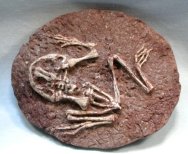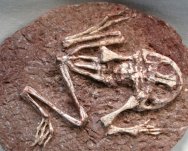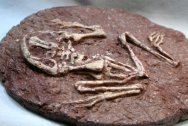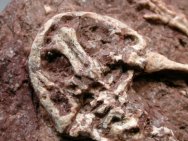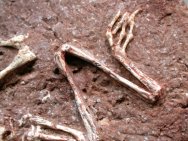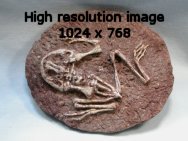 Description:
This plaque holds a very rare fossil: a frog of the Family Discoglossidae,
or disk-tongued frogs. The family derives its name from its fixed
disk-like tongue. There are two extant genera known from Europe,
Noth Africa, the Middle East, and Asia: Alytes (midwife toads) and
Discoglossa, a frog that resembles the Ranidae (common frogs). Callobatrachus
is the oldest known Discoglossid, and was very briefly described
in 1999. A complete description was done in 2001 (See Journal Of
Vertebrate Paleontology 21 (3) 460-476). Description:
This plaque holds a very rare fossil: a frog of the Family Discoglossidae,
or disk-tongued frogs. The family derives its name from its fixed
disk-like tongue. There are two extant genera known from Europe,
Noth Africa, the Middle East, and Asia: Alytes (midwife toads) and
Discoglossa, a frog that resembles the Ranidae (common frogs). Callobatrachus
is the oldest known Discoglossid, and was very briefly described
in 1999. A complete description was done in 2001 (See Journal Of
Vertebrate Paleontology 21 (3) 460-476).
Frogs
of any age are most rare specimens; one from the Cretaceous, so
far back in geological time in their history, is almost unheard
of. This fine specimen shows most all of the bones in articulation.
The left radioulna is visible as it proceeds under the upper body.
I do not know if any carpals or phalanges are present to the manus.
The matrix has been stabilized to prevent loss of any of the specimen,
one which is worthy of any museum-quality collection. |

